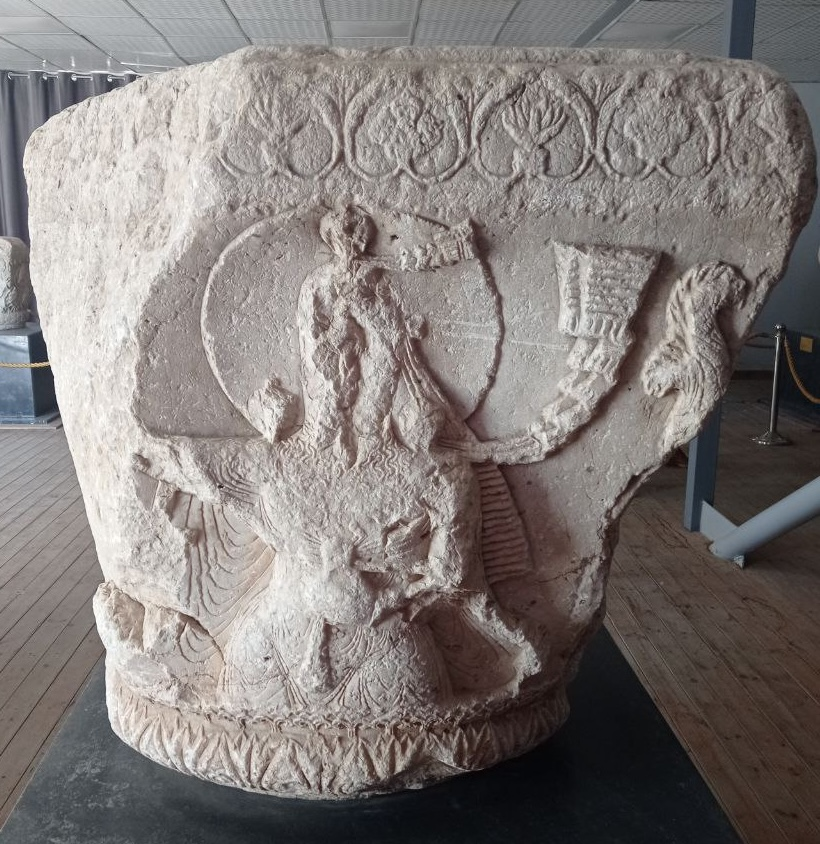#MythologyMonday Thread: Codex-style plate depicting the rebirth of the Maize god. Maya, Late Classic Period. 680–740AD...Currently kept in the Museum of Fine Arts Boston collections.mfa.org/objects/36320
In this thread I would like to analyse the scene description which says:
In this thread I would like to analyse the scene description which says:

"Maize god emerges from the Underworld through a cracked turtle shell, symbolizing the earth. The Hero Twins pour water onto their father to facilitate his resurrection, as Maya farmers water maize seeds to help them sprout"...
So corn god "emerging from the Underworld" is a symbolic depiction of a corn sprouting...So when does corn sprout in the Maya land? In the 1848 book "Incidents of Travel in Yucatan, Vol. I" (gutenberg.org/files/33129/33…) by John L. Stephens we read that: 

"In the dry season...Jan/Feb...a place is selected in the woods, from which the trees are cut down and burned. In...May/Jun...the corn is planted...by making little holes in the ground with a pointed stick, putting in a few grains of corn and covering them over..."
Local farmers in the old Maya lands even today plant corn in Apr/May/Jun, with planting season peaking in May...And, it takes only 4 days at 25 degrees celsius or more for corn to sprout...
Soooo...Turtle...Why "emerging through cracked turtle shell"...
Any guesses? Maaaaaybe this is another animal calendar marker, derived from a major turtle annual reproductive lifecycle event?
Bingo...
Any guesses? Maaaaaybe this is another animal calendar marker, derived from a major turtle annual reproductive lifecycle event?
Bingo...
When Maya made their mythology, every year, from May to Sep, thousands and thousands of sea turtles descended on the beaches of Central America to lay their eggs...They still do today... 

Guess what happens in Maya land, right when the first turtle comes to lay its eggs, in May? Corn planting begins...
Guess what happens in Maya land right when the last turtle lays its eggs, in Oct? Corn harvest begins...
Guess what happens in Maya land right when the last turtle lays its eggs, in Oct? Corn harvest begins...

So corn god "emerging through cracked turtle shell"...
I am sure that turtles were a major food source for the Mayas...You can only hunt turtles during their nesting season, which is also corn growing season...And to get to the turtle meet you have to break the turtle's shell...
I am sure that turtles were a major food source for the Mayas...You can only hunt turtles during their nesting season, which is also corn growing season...And to get to the turtle meet you have to break the turtle's shell...
BTW, this is not the only place in the world where we find turtles (tortoises) as animal calendar markers...
Remember this thread about turtles in Indian mythology?
Remember this thread about turtles in Indian mythology?
https://twitter.com/serbiaireland/status/1575216584485765125
And this article about turtles in Sumerian mythology?
https://twitter.com/serbiaireland/status/1574018542193745923
And this article about "The lyre of Apollo" and turtle (tortoise) in Greek mythology?
oldeuropeanculture.blogspot.com/2022/10/lyre-o…
All animal calendar markers linked with fertility of the land and grain agriculture...
oldeuropeanculture.blogspot.com/2022/10/lyre-o…
All animal calendar markers linked with fertility of the land and grain agriculture...

Now what about "The Hero Twins pour water onto their father to facilitate his resurrection"?
Well here we have to look at the climate in the Maya territory. Here is Yucatan climate chart...It is hot year-round. The wet season usually starts in Jun and ends in Oct...
Well here we have to look at the climate in the Maya territory. Here is Yucatan climate chart...It is hot year-round. The wet season usually starts in Jun and ends in Oct...

See how rain season proper starts in Jun, right after the planting of corn? Do you know of any twins which like to hang around Jun? I do...All the horse twins from Eurasia...oldeuropeanculture.blogspot.com/2022/06/hayagr… 

They mark summer solstice...The moment which marks the middle of the solar year. Solar year which starts when the old sun dies and is reborn as the new sun, on winter solstice...Two halves...Twins? 

Mayan calendar also started on winter solstice...And considering that in Maya land, the time of the twins, Jun/Jul, is also the time when the rains arrive, we have the twins (rain season) pouring water on the resurrecting (growing) corn (god)... 

BTW, this just reminded me of another pair of twins...Well actually it's a single god, Hapi, the god of the annual flooding of the Nile, who was "often depicted as twins, tying papyrus and lotus flowers together". I talked about him/them 🙂 here oldeuropeanculture.blogspot.com/2022/09/lotus-… 

In my article I said that "this depiction of Hapi as twins, is depiction of flooding Nile, which rises between flowering of papyrus and flowering of lotus, when it floods... 

But I completely missed the fact that in the middle of this period between flowering of papyrus (Apr/May) and flowering of lotus (Jul/Aug) is Summer solstice...The twins central...🙂
Does this make sense? For more about ancient animal and plant calendar markers, start here oldeuropeanculture.blogspot.com/p/animal-solar… then check the rest of the blog posts I still didn't add to this page, then check my twitter threads I still didn't convert to blog post...I am 9 months behind.
• • •
Missing some Tweet in this thread? You can try to
force a refresh























